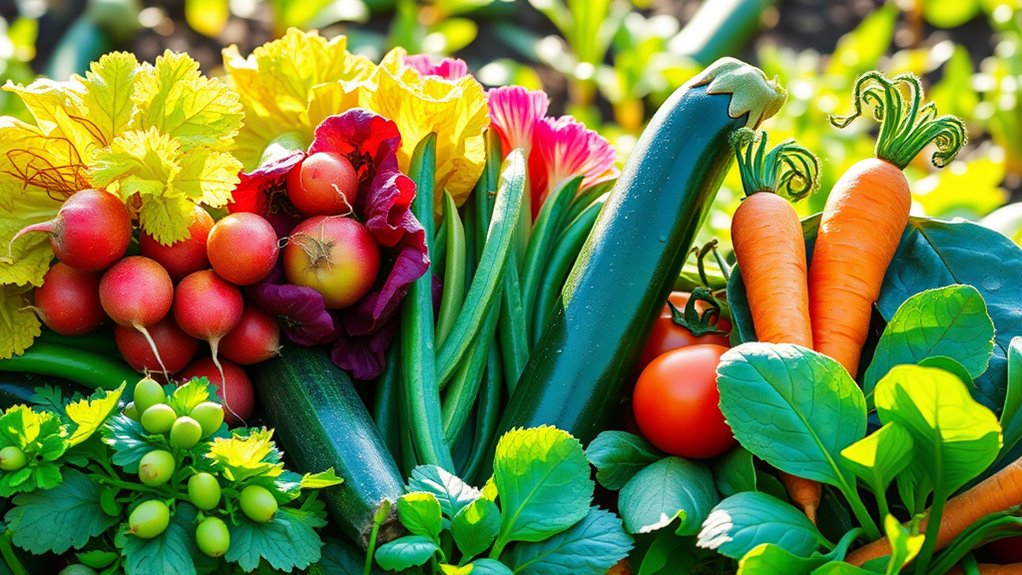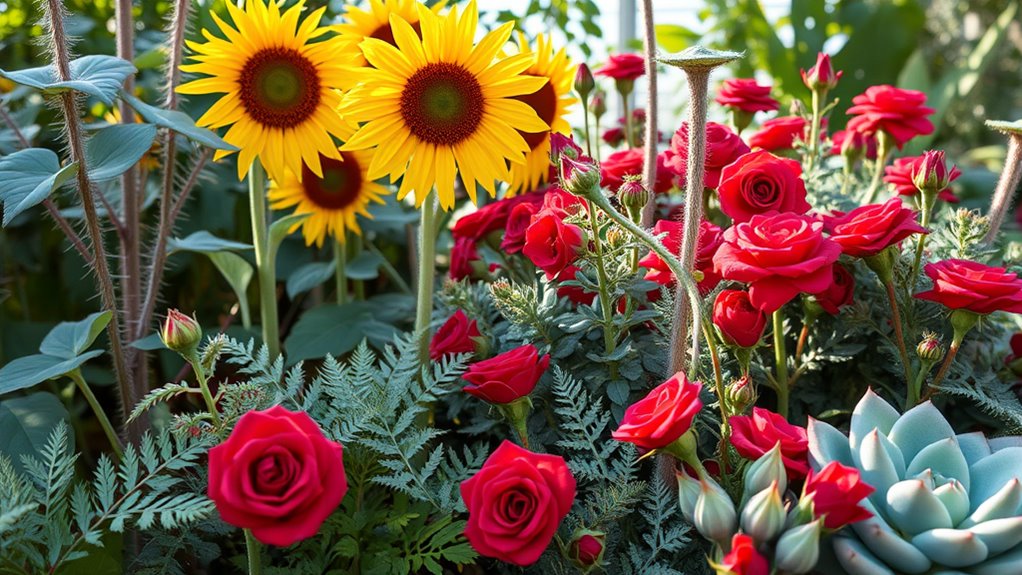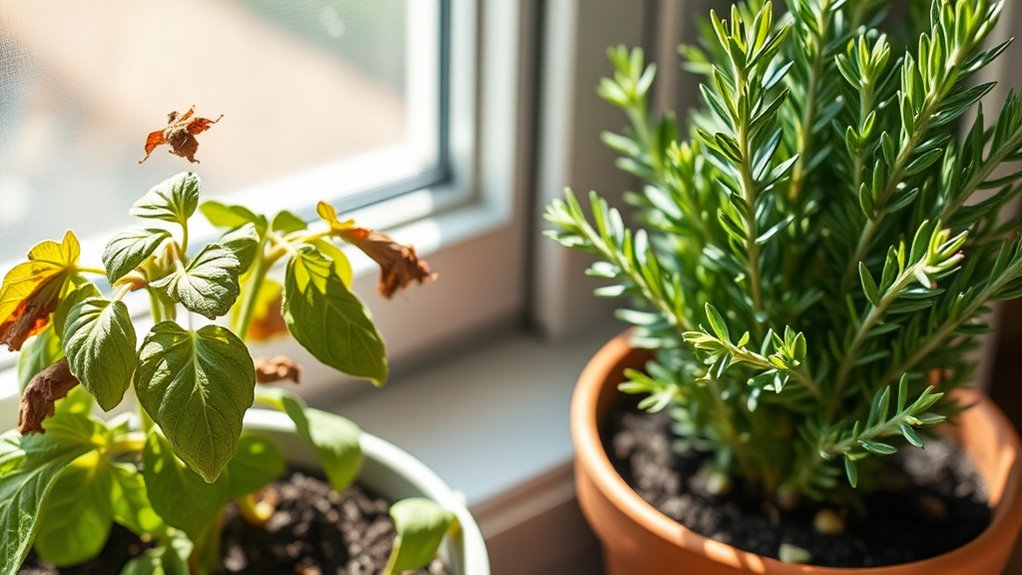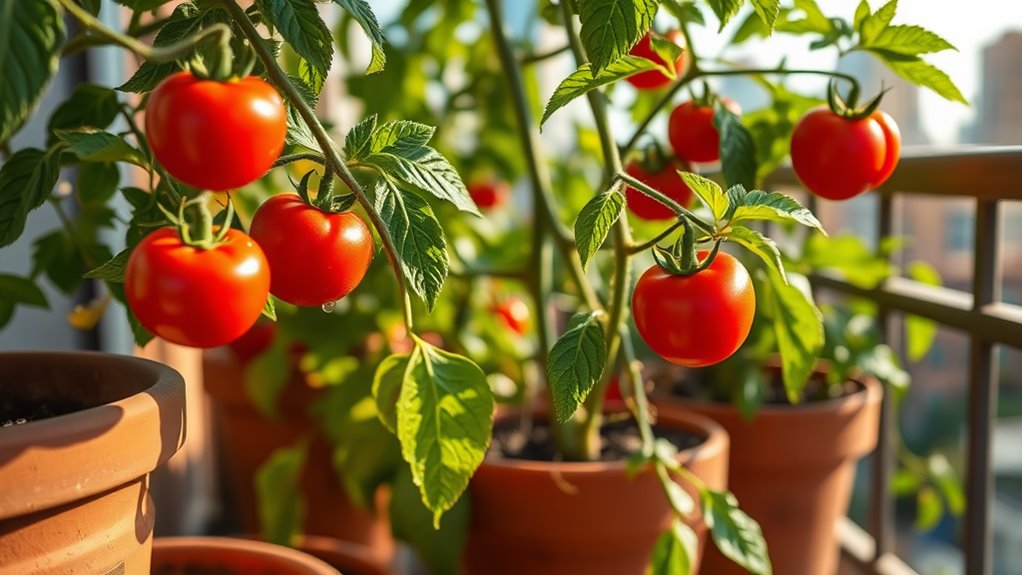7 Vegetables That Practically Grow Themselves
You’ll find these seven low-maintenance vegetables thrive with minimal effort. Sow radish seeds half an inch deep for harvests in just 3-4 weeks. Scatter lettuce seeds a few inches apart for fresh greens in weeks. Plant green beans after the last frost, then pick regularly as they grow. Zucchini yields quickly in 45-60 days with basic watering. Cucumbers need consistent moisture and trellising for firm fruits. Carrots flourish in deeply loosened soil with little fuss. Spinach provides easy nutrition; these tips will help you boost your garden’s potential.
Key Takeaways
- Radishes grow quickly from seed to harvest in 3-4 weeks with minimal care and well-drained soil.
- Lettuce thrives when sown directly into moist soil, ready for harvesting in just a few weeks.
- Green Beans require simple planting after frost and consistent watering for easy, ongoing yields.
- Zucchini produces fruits in 45-60 days with basic care like occasional watering in warm soil.
- Cucumbers develop in 8-12 weeks in well-drained soil, needing only regular watering and pest checks.
Radishes
Radishes are one of the quickest vegetables you’ll grow with minimal effort, sprouting from seed to harvest in just 3-4 weeks.
For easy vegetable gardening, choose a sunny spot with loose, well-drained soil and sow seeds directly in early spring. Plant them half an inch deep, one inch apart, then thin to two inches to promote healthy roots. According to beginner’s guides, selecting the right location and soil can further simplify the process for new gardeners.
Keep soil evenly moist to prevent cracking, and mulch for weed control. Radishes resist most diseases but watch for pests like root maggots; use barriers if needed.
Harvest when they’re marble-sized for peak flavor. This makes them ideal for beginners.
For those starting their home garden journey, radishes are just the beginning of easy-to-grow options.
Lettuce
You sow lettuce seeds easily by scattering them directly into moist soil, ensuring they’re spaced a few inches apart for optimal growth.
Once the seeds sprout, you’ll water them sparingly and weed lightly to keep the plants thriving with minimal effort.
This approach lets you harvest fresh leaves in just weeks while enjoying a hassle-free garden. Additionally, incorporating essential soil steps can help create a more nutrient-rich bed for better yields.
For even better results, prioritize soil preparation to create the ideal environment for your lettuce plants.
Easy Seed Sowing
Sowing lettuce seeds is a simple process that yields fresh greens quickly.
You’ll prepare the soil by loosening it to about six inches deep and mixing in compost for nutrient-rich conditions. Choose a spot with good drainage and partial sun to optimize germination.
Sow seeds directly in rows, placing them no deeper than a quarter inch, as they require light exposure for best results. Space them one inch apart to allow room for growth.
Water gently right after sowing to keep the soil moist but not saturated. Expect sprouts in 7-14 days at 50-70°F, making this method efficient and reliable.
Low Maintenance Tips
After your lettuce sprouts, maintaining it becomes straightforward with minimal effort.
Water your plants regularly to keep the soil evenly moist, preventing bolting and ensuring tender leaves. Use a soaker hose for efficient irrigation, minimizing evaporation and root disturbance.
Weed the bed weekly to reduce competition for nutrients and light. Apply organic mulch, like straw, to retain moisture and suppress weeds naturally.
Monitor for pests such as aphids or slugs, removing them by hand or using insecticidal soap.
Harvest outer leaves frequently to promote regrowth, extending your harvest season with minimal intervention.
Green Beans
While green beans thrive in warm soil with minimal intervention, they offer a low-maintenance option for home gardeners seeking high yields.
You plant seeds directly after the last frost, spacing them 2-3 inches apart in full sun. They’re nitrogen-fixing, enriching your soil naturally, so skip heavy fertilizers.
Water consistently at the base to avoid disease, and mulch to suppress weeds. For pole types, install simple trellises; bush varieties spread on their own.
Monitor for common pests like bean beetles, using organic sprays if needed.
Harvest every few days when beans snap easily, ensuring continuous production with ease. This approach can help you achieve a bountiful harvest by incorporating proven gardening techniques.
As one of the seven low-maintenance vegetables perfect for beginners, green beans deliver a bountiful harvest with minimal effort.
Zucchini
Zucchini flourishes in warm soil with minimal fuss, delivering bountiful harvests for home gardeners. You’ll plant seeds directly after the last frost, ensuring full sun and well-drained soil for optimal growth. As a fast-growing vine, it thrives with minimal watering and occasional feeding, yielding fruits in just 45-60 days. Harvest when they’re 6-8 inches long to encourage more production. For those new to gardening, following step-by-step guidance can make the process even more straightforward and enjoyable.
| Growth Stage | Key Practice | Expected Outcome |
|---|---|---|
| Seeding | Sow in 1-inch depth | Germination in 7 days |
| Sprouting | Water evenly | Strong root development |
| Flowering | Provide bee access | Abundant pollination |
| Fruit Set | Mulch to retain moisture | Rapid fruit expansion |
| Maturing | Pick every 2-3 days | Continuous yields |
This low-maintenance crop lets you enjoy fresh produce with little effort, boosting your garden’s productivity. By focusing on sustainable practices, you can extend these benefits to a thriving organic garden year-round.
Cucumbers
You plant cucumber seeds easily in your garden by sowing them directly into well-drained soil.
You’ll water them consistently and use trellising to guide their vines for optimal growth.
In a matter of weeks, you’re harvesting crisp cucumbers right from your patch.
As low-effort plants, cucumbers are ideal for beginners due to their simple care needs.
Cucumbers are especially suitable for tiny garden spaces due to their compact growth habits that maximize yield in limited areas.
Planting Seeds Easily
Cucumbers offer a straightforward way to grow your own vegetables from seeds, as they germinate quickly in the right conditions.
You’ll start by selecting fresh seeds from a reliable source to ensure high viability. Sow them directly into well-drained soil that’s been warmed to at least 70°F (21°C) for optimal sprouting.
Plant seeds about an inch deep and space them 12 inches apart in rows. Use a simple soil test to check pH levels around 6.0-7.0, which promotes easy root development.
This method minimizes effort while maximizing success in your garden.
Watering and Trellising
Once your cucumber seeds have sprouted, consistent watering and trellising become essential for robust growth.
You’ll keep soil evenly moist to avoid stress, aiming for 1-2 inches of water weekly, while trellising supports vines to enhance air circulation and reduce pests.
- Water early in the morning to minimize evaporation and fungal risks.
- Install a simple trellis using stakes and twine for vertical support.
- Monitor soil pH around 6.0-7.0 to optimize nutrient uptake.
- Prune excess growth actively to focus energy on fruit development.
Harvesting in Weeks
After supporting your cucumber plants through watering and trellising, harvesting generally starts 8-12 weeks from planting, based on the variety.
You’ll know they’re ready when fruits reach 6-8 inches long, feel firm, and show a vibrant green hue. Check daily for optimal ripeness, as overripe ones turn yellow and bitter.
Use sharp shears to cut stems carefully, avoiding vine damage to encourage more yields. Harvest every 2-3 days in the cool morning for best flavor and texture.
Store picked cucumbers in the fridge; this practice extends shelf life and maintains quality.
Always inspect for pests during picking to sustain plant health.
Carrots
Carrots are hardy root vegetables that thrive with minimal intervention, making them a prime example of self-sufficient crops. You’ll appreciate how they adapt to different soils and weather, requiring only basic care like occasional weeding and light watering to yield crisp, nutrient-rich roots. To ensure their effortless growth, be aware of companion planting principles that can prevent conflicts with certain neighboring vegetables. For example, combining carrots with onions can deter pests while enhancing garden productivity.
-
Select varieties wisely: Choose disease-resistant types suited to your region’s climate for optimal growth.
-
Prepare soil effectively: Loosen it deeply to 12 inches to promote straight, healthy carrots.
-
Space seeds properly: Sow them 2-3 inches apart to avoid overcrowding and ensure even development.
-
Monitor moisture levels: Water consistently but sparingly to prevent splitting and encourage deep roots.
Spinach
Spinach is a nutrient-dense leafy green that thrives in cooler climates with minimal effort, letting you harvest fresh yields through simple practices like timely sowing and light watering.
You’ll succeed by choosing well-drained soil with a pH of 6.5 to 7.0, sowing seeds directly in early spring or fall at 3-inch intervals.
Keep the soil moist but not saturated to prevent bolting in heat. Monitor for aphids and use organic controls like neem oil.
In 40-45 days, you’ll enjoy vitamin-rich leaves for salads, boosting your health with iron, vitamins A, C, and K effortlessly.





